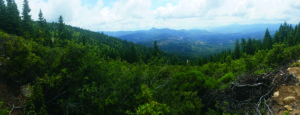
Summer 2018 ForestLife
Restoring carbon rich, climate resilient forests across the west coast
Washington, Oregon, and California take action on forests and climate
With the impact of climate change increasingly visible across our lives and landscapes, states are stepping up to take action in the absence of national leadership—indeed, in the face of national obstruction. Washington state has a major climate initiative on its November ballot, which appears poised to succeed. Oregon is preparing significant climate legislation for its upcoming 2018-2019 session. And California is hosting the Global Climate Action Summit in September 2018, convening leaders from across the country and the world, demonstrating their commitments to reducing climate change and highlighting accomplishments to date. PFT is pleased to be deeply involved in these efforts, advancing the role of forests, especially our temperate forests, as a key tool to help both mitigate and adapt to climate change.
At the direction of Governor Kate Brown and the legislature, Oregon has convened two working groups on the role of forests and other lands in climate policy and future policy implementation. PFT is participating in both the Forest Carbon work group and the Natural and Working Lands work group, sharing our learning and expertise from decades of work in the field as well as in helping shape and implement California’s climate policy. In the efforts to pass a climate law in Oregon’s 2017-2018 session, it was clear that forests and other lands should play a role, but there were many questions about what that role should be. These work groups will help provide the foundation for the upcoming legislation.
In Washington’s Initiative 1631, forests play a notable role; their inclusion has been an influential measure in gaining support. In earlier polling, the inclusion of forest and watershed protection increased support for the initiative by some 12% (See ForestLife, Summer 2017).
In both states, some of the same questions that California has addressed in the past decade of implementing AB 32 (extended through SB 32) are arising: What do we want these forests and landscapes to look like in 50 or 100 years? How do we inventory and account for forest- and land-based carbon? What are the most effective climate investments that can be made? What CO2 emissions reduction target should be set for forests? Can we make assumptions about wood-based energy being carbon neutral, or do we need actual accounting and long-term agreements to back that assumption up? When we invest in restoring more resilient forests for their long-term sequestration, water, and other adaptation benefits, how do we ensure those investments bear fruit over time?
How these states answer these questions is critical. We share the same forest types and, most importantly, must account for CO2 emissions and reductions with accuracy similar to what we would need for a currency system. We need carbon accounting in our books that reflects CO2 emissions in the atmosphere, rather than making assumptions about what they are. While no system is perfect, California’s experience is a useful guide. This September, as part of the Global Climate Action Summit, PFT is hosting a discussion on these issues with Hilary Franz, Washington’s statewide elected Commissioner for Natural Resources; Meta Loftsgaarden, Executive Director of Oregon’s Watershed Enhancement Board; and Ashley Conrad-Saydah, Deputy Director of California’s Air Resources Board. A key goal is to identify shared approaches that will yield the most benefit for these states’ shared forests, forest communities, and our globally shared climate.
More in this Issue of ForestLife
- President’s Letter
- A first for Oregon: Mountcrest Forest conserved
- What price a watershed?
- Pioneering progress on forest and climate policy
- Donor Profile: Andrea Tuttle, PhD
- Saving beavers, headwaters, and tall timbers at McCloud Soda Springs
- Forestry at Soda Springs: Back to the future
- A fabulous Forest Fete!

